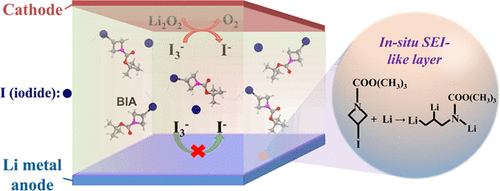当前位置:
X-MOL 学术
›
ACS Appl. Mater. Interfaces
›
论文详情
Our official English website, www.x-mol.net, welcomes your
feedback! (Note: you will need to create a separate account there.)
Bifunctional 1-Boc-3-Iodoazetidine Enhancing Lithium Anode Stability and Rechargeability of Lithium–Oxygen Batteries
ACS Applied Materials & Interfaces ( IF 8.3 ) Pub Date : 2021-03-31 , DOI: 10.1021/acsami.1c02192 Yan-Ni Li 1, 2 , Fang-Ling Jiang 1 , Zhuang Sun 1 , Osamu Yamamoto 3 , Nobuyuki Imanishi 3 , Tao Zhang 1, 2
ACS Applied Materials & Interfaces ( IF 8.3 ) Pub Date : 2021-03-31 , DOI: 10.1021/acsami.1c02192 Yan-Ni Li 1, 2 , Fang-Ling Jiang 1 , Zhuang Sun 1 , Osamu Yamamoto 3 , Nobuyuki Imanishi 3 , Tao Zhang 1, 2
Affiliation

|
Lithium anode protection is an effective strategy to prohibit the continuous loss of redox mediators (RMs) resulting from the unfavorable “shuttle effect” in lithium–oxygen batteries. In this work, an in situ Li anode protection method is designed by utilizing an organic compound, 1-Boc-3-iodoazetidine (BIA), as both a RM and an additive, to form a lithium anode protective layer. The reaction between Li metal and BIA can form lithium iodide (LiI) and lithium-based organometallic. LiI can effectively reduce the charging overpotential. Meanwhile, the in situ-formed anode protection layer (lithium-based organometallic) can not only effectively prevent RMs from being reduced by the lithium metal, but also inhibit the growth of lithium dendrites. As a result, the lithium–oxygen battery with BIA shows a long cycle life of 260 cycles with a notably reduced charging potential. In particular, the battery with BIA achieves an excellent lifespan of 160 cycles at a large current density of 2000 mA g–1.
中文翻译:

双功能1-Boc-3-碘氮杂环丁烷增强锂氧电池的锂阳极稳定性和可充电性
锂阳极保护是一种有效的策略,可以防止氧化锂电池因不利的“穿梭效应”而导致氧化还原介体(RM)连续丢失。在这项工作中,通过利用有机化合物1-Boc-3-iodoazetidine(BIA)作为RM和添加剂来设计原位Li阳极保护方法,以形成锂阳极保护层。锂金属和BIA之间的反应可以形成碘化锂(LiI)和锂基有机金属。LiI可以有效降低充电过电势。同时,原位形成的阳极保护层(锂基有机金属)不仅可以有效地防止RMs被锂金属还原,而且可以抑制锂树枝状晶体的生长。因此,具有BIA的锂氧电池显示260个循环的长寿命,并且充电电位显着降低。特别是,带有BIA的电池在2000 mA g的大电流密度下可实现160次循环的出色使用寿命。–1。
更新日期:2021-04-14
中文翻译:

双功能1-Boc-3-碘氮杂环丁烷增强锂氧电池的锂阳极稳定性和可充电性
锂阳极保护是一种有效的策略,可以防止氧化锂电池因不利的“穿梭效应”而导致氧化还原介体(RM)连续丢失。在这项工作中,通过利用有机化合物1-Boc-3-iodoazetidine(BIA)作为RM和添加剂来设计原位Li阳极保护方法,以形成锂阳极保护层。锂金属和BIA之间的反应可以形成碘化锂(LiI)和锂基有机金属。LiI可以有效降低充电过电势。同时,原位形成的阳极保护层(锂基有机金属)不仅可以有效地防止RMs被锂金属还原,而且可以抑制锂树枝状晶体的生长。因此,具有BIA的锂氧电池显示260个循环的长寿命,并且充电电位显着降低。特别是,带有BIA的电池在2000 mA g的大电流密度下可实现160次循环的出色使用寿命。–1。































 京公网安备 11010802027423号
京公网安备 11010802027423号